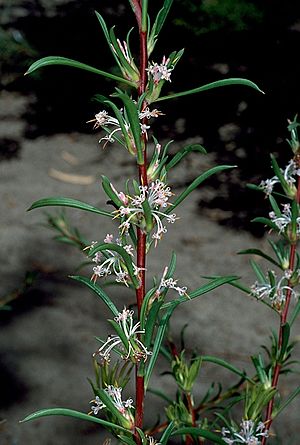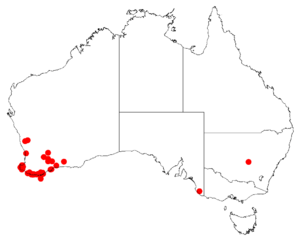Isopogon axillaris facts for kids
Isopogon axillaris is a special plant that belongs to the Proteaceae family. It is found only in the south-west part of Western Australia. This plant is a type of shrub. It has thick, long leaves that are narrow at the bottom. It also has pretty oval-shaped flowers that can be pink or purple.
Quick facts for kids Isopogon axillaris |
|
|---|---|
 |
|
| In Kings Park Botanic Gardens | |
| Scientific classification | |
| Genus: |
Isopogon
|
| Species: |
axillaris
|
 |
|
| Occurrence data from Australasian Virtual Herbarium | |
| Synonyms | |
|
Atylus axillaris (R.Br.) Kuntze |
|
Contents
What Does Isopogon axillaris Look Like?
This plant is a shrub that usually grows to be about 0.4 to 1.2 meters tall. Its branches are smooth and brown.
Leaves of the Plant
The leaves of Isopogon axillaris are long and narrow. They can be between 15 and 90 millimeters long. They are also about 5 to 10 millimeters wide. The leaves are attached directly to the stem without a stalk.
Flowers and Fruit
The flowers grow in oval-shaped clusters. These clusters are found where the leaves meet the stem. Each flower cluster can be up to 35 millimeters long. They have small, overlapping leaf-like parts at their base. The flowers themselves are 25 to 35 millimeters long. They are usually a pale pink to purplish-pink color.
Isopogon axillaris flowers bloom from July to October. After flowering, the plant produces a fruit. This fruit is a round, hairy nut. Many of these nuts grow together in an oval-shaped head. This head is about 10 millimeters across.
How Isopogon axillaris Got Its Name
The plant Isopogon axillaris was officially named in 1810. It was named by a botanist named Robert Brown. He described the plant in a scientific paper. This paper was published by the Linnean Society of London.
Where Isopogon axillaris Grows
This type of isopogon plant likes to grow in wet or swampy areas. You can find it in the south-west of Western Australia. Its range stretches from near Karridale all the way to Albany.
Is This Plant in Danger?
The good news is that Isopogon axillaris is not considered to be a threatened plant. The Government of Western Australia's Department of Parks and Wildlife has classified it as "not threatened." This means it is not currently at risk of disappearing.

